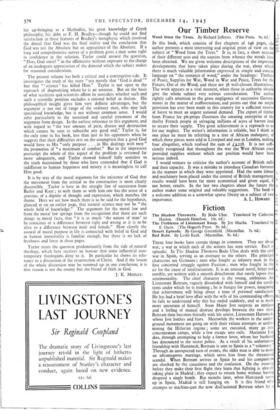Our Timber Reserve
Wood from the Trees. By Richard Jefferies. (Pilot Press. 9s. 6d.)
IN this book, which consists of five chapters of 546 pages, thc author presents a most interesting and original point of view on the subject of " Wood from the Trees." It is, in fact, a short account of their different uses and the sources from whence the woods hay,: been obtained. We are given welcome descriptions of the important developments that have taken place during the war, about which there is much valuable information expressed in simple and concise language on " the romance of wood," under the headings: Timber, of Peace, Supplies for War, Wood in War and Peace, Trees for the Future, Out of the Wood, and there are 38 well-chosen illustrations. The work appears at a vital moment, when those in authority should give the whole subject very serious consideration. The author rightly calls attention to the gross negligence of successive Govern- ments in the matter of reafforestation, and points out that no ample provision has ever been made in this country for a sufficient reserve of forest to meet an urgent national demand. The export of timber from France for pit-props illustrates the amazing enterprise of the thrifty French people in salvaging millions of acres of barren land to secure their supply. This great achievement is a reproach to us for our neglect. The writer's information is reliable, but I think in one place he must be referring to a tree of African mahogany, of which three pieces were sold in Liverpool and one in London, making four altogether, which realised the sum of £4,228. It is not suffi- ciently recognised that throughout the war the West African coast provided supplies without which our position would have been serious indeed.
I would venture to criticise the author's account of British mills and their capacity. It was a mistake to introduce Canadian foresters in the manner in which they were appointed. Had the same labour and machinery been placed under the control of British management, results would have been far more economical and given equal, if not better, results. In the last two chapters about the future the author makes some original and valuable suggestions. The book is a welcome addition to a somewhat sparse library on a subject of vast


























 Previous page
Previous page